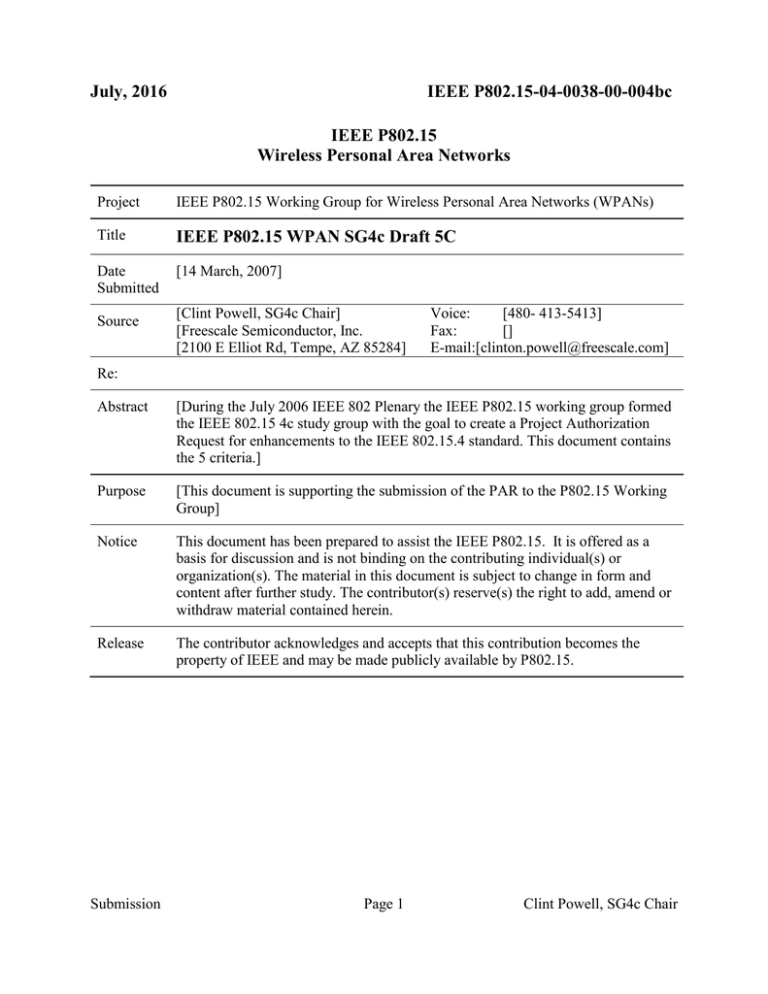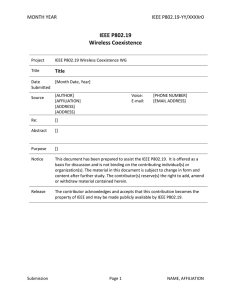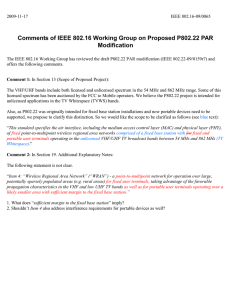July, 2016 IEEE P802.15-04-0038-00-004bc IEEE P802.15 Wireless Personal Area Networks
advertisement

July, 2016 IEEE P802.15-04-0038-00-004bc IEEE P802.15 Wireless Personal Area Networks Project IEEE P802.15 Working Group for Wireless Personal Area Networks (WPANs) Title IEEE P802.15 WPAN SG4c Draft 5C Date Submitted [14 March, 2007] Source [Clint Powell, SG4c Chair] [Freescale Semiconductor, Inc. [2100 E Elliot Rd, Tempe, AZ 85284] Voice: [480- 413-5413] Fax: [] E-mail:[clinton.powell@freescale.com] Re: Abstract [During the July 2006 IEEE 802 Plenary the IEEE P802.15 working group formed the IEEE 802.15 4c study group with the goal to create a Project Authorization Request for enhancements to the IEEE 802.15.4 standard. This document contains the 5 criteria.] Purpose [This document is supporting the submission of the PAR to the P802.15 Working Group] Notice This document has been prepared to assist the IEEE P802.15. It is offered as a basis for discussion and is not binding on the contributing individual(s) or organization(s). The material in this document is subject to change in form and content after further study. The contributor(s) reserve(s) the right to add, amend or withdraw material contained herein. Release The contributor acknowledges and accepts that this contribution becomes the property of IEEE and may be made publicly available by P802.15. Submission Page 1 Clint Powell, SG4c Chair July, 2016 IEEE P802.15-04-0038-00-004bc IEEE P802.15 Low Rate Wireless Personal Area Networks Study Group Functional Requirements Standards Development Criteria The IEEE P802.15 4c Study Group for Wireless Personal Area Networks (WPANs) reviewed and completed the required IEEE Project 802 Functional Requirements, Standards Development Criteria (a.k.a. the Five Criteria). The IEEE 802.15 WPAN Five Criteria response is in Italics below. 1. BROAD MARKET POTENTIAL a) Broad sets of applicability There is increasing interest for Low Rate Wireless Personal Area Network (WPAN-LR). Especially in China, sub 1 Giga band is required for the many applications of WPAN-LR. Examples of applications include Home Automation, Meter Reading, Medical Monitoring, Precision Agriculture and Environmental Networks, Industrial Controls, and Access/Authorization. Examples of devices include Smart Tags & Badges, Auto Location ID’s, Stick-on and Security Sensors, Interactive Toys, Human Interface Devices ( HIDs), Portable bar code readers, and Remote controls. With an effective wireless standard, geared to this class of applications, the Chinese market potential is huge. The wireless capability will make these devices easier to use and provide additional functionality and efficiency. b) Multiple vendors and numerous users The breadth of membership of this WPAN Low Rate Study Group demonstrates the interest in this class of WPANs. Members include international wireless industry leaders, academic researchers, semiconductor manufacturers, system integrators, and end users. Already, there are industry consortiums, such as ZigBee and WINA actively addressing the requirements of ultra low power, low data rate wireless PAN class networks and are promoting the current standard .There are currently at least 3 semiconductor manufacturers providing semiconductor solutions for sub 1 GHz 802.15.4. The target user base will be large as indicated by the growing demand for wireless connectivity in almost all devices. c) Balanced costs (LAN versus attached stations) The proposed amendment to 802.15.4 will be developed with the aim that the connectivity costs will be a reasonably small fraction of the cost of the target devices such as sensors, tags, HIDs, and bar code readers as previously mentioned. 2. COMPATIBILITY IEEE 802 defines a family of standards. All standards shall be in conformance with IEEE 802.1 Architecture, Management and Interworking. All LLC and MAC standards shall be compatible with ISO 10039, MAC Service Definition1, at the LLC/MAC boundary. Within the LLC Working Group there shall be one LLC standard, including one or more LLC protocols with a common LLC/MAC interface. Within a MAC Working Group there shall be one MAC standard and one or more Physical Layer standards with a common MAC/Physical layer interface. Each standard in the IEEE 802 family of standards shall include a definition of managed objects, which are compatible with OSI systems management standards. Submission Page 2 Clint Powell, SG4c Chair July, 2016 IEEE P802.15-04-0038-00-004bc Note: This requirement is subject to final resolution of corrections and revision to current ISO 10039, currently inconsistent with ISO 8802 series standards. The MAC (Medium Access Control) Layer of the Wireless Personal Area Network (WPAN) Standard will be compatible with the IEEE 802 requirements for architecture, management, and inter-networking. 3. DISTINCT IDENTITY a) Substantially different from other IEEE 802 standards. 802.15.4 uniquely supports wireless sensor and control application. Without amendment, 802.15.4 will not support the new frequency allocations, 314-316 MHz, 430-434 MHz, and 779-787 MHz, proposed by the Chinese regulatory authority. b) One unique solution per problem (not two solutions to a problem). The proposed amendment to 802.15.4 will provide a unique solution for the Chinese 314-316 MHz, 430-434 MHz, and 779-787 MHz bands. c) Easy for the document reader to select the relevant specification. The proposed amendment to 802.15.4 for the Chinese 314-316 MHz, 430-434 MHz, and 779-787 MHz bands will be a clearly distinguishable specification. 4. TECHNICAL FEASIBILITY a) Demonstrated system feasibility Physical layer implementations in sub 1 GHz band are well known and well characterized. b) Proven technology, reasonable testing There are examples of technology that exist today, which will allow design and fabrication of these radio systems. c) Confidence in reliability The air interface protocol will be designed to meet commercial reliability standards. Existing products provide confidence in the reliability of the proposed project. A coexistence assurance document is not required as there are no other IEEE standard radios operating in the specified frequency bands. 5. ECONOMIC FEASIBILITY a) Known cost factors, reliable data High volume applications in the Chinese 314-316 MHz, 430-434 MHz, and 779-787 MHz bands provide a low cost source of components. Existing products indicate cost targets are easily met. b) Reasonable cost for performance Submission Page 3 Clint Powell, SG4c Chair July, 2016 IEEE P802.15-04-0038-00-004bc Based on test results, prototype, and production solutions, the estimates meet expected size, cost, and power requirements. c) Consideration of installation costs One of the 802.15.4 standard objectives includes low cost installation with minimal to no operator intervention. Submission Page 4 Clint Powell, SG4c Chair



